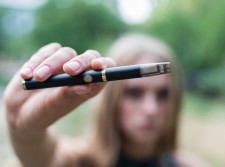Talking with your teen about vaping
Before the talk: Get the facts
Vaping is not harmless
- Vaping can increase your exposure to harmful chemicals.
- Vaping can lead to nicotine or cannabis addiction.
- The long-term consequences of vaping are unknown.
- It’s rare, but defective vaping products (especially batteries) may catch fire or explode, leading to burns and injuries.
Risks of nicotine
Nicotine is a highly addictive chemical. Youth are especially susceptible to its negative effects, as it can alter their brain development and can affect memory and concentration. It can also lead to addiction and physical dependence. Children and youth may become dependent on nicotine more rapidly than adults.
Although not all vaping products contain nicotine, the majority of them do, and the level of nicotine can vary widely. Some vaping liquids have low levels, but many have levels of nicotine similar or higher than in a typical cigarette. Quitting vaping can be challenging once a teen has developed an addiction to nicotine. Nicotine withdrawal symptoms can be unpleasant.
Even if a vaping product does not contain nicotine, there is still a risk of being exposed to other harmful chemicals.
Vaping versus smoking
For people who smoke, completely replacing cigarette smoking with vaping will reduce their exposure to harmful chemicals. However, it is not safe for youth to use any nicotine products, including cigarettes and vaping products. If you suspect your child is addicted to nicotine, talk to your healthcare provider.
Vaping liquids
The ingredients typically found in vaping liquids include glycerol, flavours, propylene glycol and varying levels of nicotine or cannabis. The long-term safety of inhaling these substances in vaping products is unknown and continues to be assessed.
The heating process can cause reactions and create new chemicals, such as formaldehyde. Some contaminants, such as metals, might also get into the vaping products and then into the aerosol.
Vaping and cannabis
Cannabis can be consumed in different ways, including by vaporizing and vaping (breathing in dried cannabis or liquid cannabis vapors through a device). Vaping cannabis, once considered a safer alternative to smoking, is not without risks. Cannabis vaping has recently been linked to vaping-associated lung illnesses. Cannabis vaping products are also often very concentrated, which can increase the chances that a young person who uses them experiences negative health effects like anxiety, paranoia or hallucinations.
Did you know?
- Data from a recent Health Canada survey showed that 23% of students in grades 7–12 have tried an electronic cigarette.
- Vaping products can be difficult to recognize:
- Devices come in a variety of shapes and sizes, and some resemble a USB flash drive;
- Liquids can have high levels of nicotine and come in a variety of flavours;
- Vaping may not leave a lingering identifiable smell; and,
- Add-ons like vinyl “skins” or wraps can also make these items harder to recognize.
- Vaping products have many names, such as: E-cigarettes, vape pens, vapes, mods, tanks, and e-hookahs. They may also be known by various brand names.
- The Tobacco and Vaping Products Act prohibits vaping products to be sold or given to anyone under the age of 18. Be aware of the laws in your province or territory, as some have increased the age to 19.
Set a positive example
If you use tobacco or vaping products, be honest with your teen about the risks, and any regrets, difficulties and health effects resulting from your experience. Talk with your teen about when and why you started to smoke/vape and explain how you thought it would make you feel, and how it is affecting your health.
It is never too late to quit smoking. If you are vaping to help you quit smoking, talk with your teen about it. Talk to them about addiction and how hard it can be to quit smoking. And remember, quitting smoking is possible. For free help, visit gosmokefree.gc.ca/quit or call 1-866-366-3667.
Start the conversation
Find the right moment
- Take advantage of situations where you can talk about vaping. It doesn’t have to be formal. For example, when passing by a group of teenagers who are vaping, take the opportunity to have a conversation with your teen about it. Discuss the facts and correct any misconceptions.
Be patient and ready to listen
- Avoid criticism and encourage an open dialogue.
- Remember, your goal is to have a meaningful conversation, not to give a lecture.
- Thank your teen for being honest with you if they tell you that they have tried vaping or vape regularly. Then offer to share some information about the risks of vaping, and discuss the benefits of being smoke- and vape-free.
Get support
- Ask your healthcare provider to talk with you and your teen about the risks of vaping and ways to be smoke- and vape-free.
- Consider suggesting that your teen talk with other trusted adults, such as relatives, teachers, faith leaders, coaches, or counsellors whom you know are aware of the risks of vaping. These supportive adults can help reinforce your message.
Keep the conversation going
- Don’t expect to have just one conversation with your teen. Odds are you will probably need to talk about the subject many times and in many different places.
- Strike up a conversation again, whenever you have some time together. You will also find that as your teen grows, your conversations about vaping will change and reflect their growing maturity, intellectual abilities and the pressures they face.
- Keep in mind that talking about it can also set the stage for important discussions about tobacco, alcohol, cannabis, drugs and other risky behaviours.
Reviewed by the following CPS committees
- Adolescent Health Committee
- Public Education Advisory Committee
Last updated: May 2020

